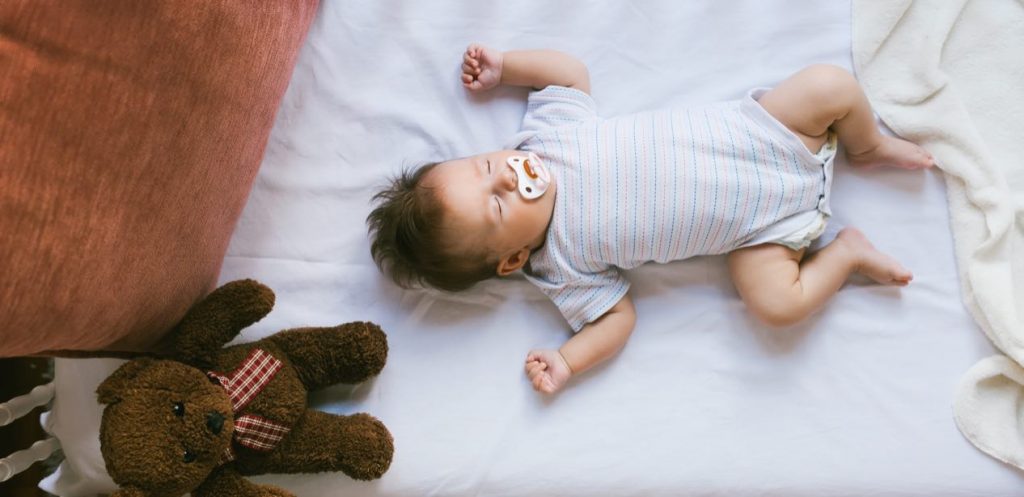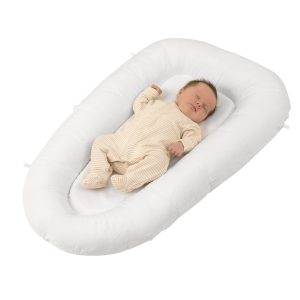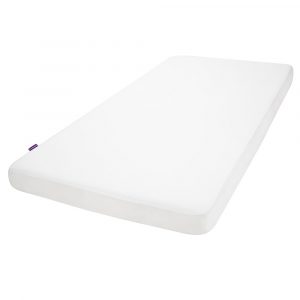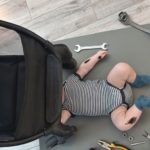The right baby cot and cot bed mattress and bedding are essential to keep your baby comfortable and safe while they sleep. Here are some important tips we recommend when preparing your baby’s mattress and bedding
Firstly, the safest place for your baby to sleep on their own sleep surface, in the same room as you for at least the first six months. It is vital to make sure that your baby is a comfortable temperature – not too hot or too cold. A room temperature of 16-20°C – with light bedding or a lightweight, well-fitting baby sleep bag– is comfortable and safe for sleeping babies.
Spend time choosing the right mattress for your baby; it is one of the most important purchases for their wellbeing and safety. Your baby will be asleep for up to 12 hours a day, so making sure that you have a secure and safe place for him or her to rest is essential. Dirty and used mattresses have been linked in the past to several risks, so follow our six safety guidelines for a peaceful (and safe) night’s sleep.
Choosing you baby’s mattress
1| Buy the right size mattress for your baby’s bed.
If it’s the wrong size, your baby could become stuck in the gap between the mattress and the cot. As a rule, this gap should be no more than 4cm (1.5 in).
2| New not old.
For hygiene purposes, we recommend you buy a new mattress for your baby, even if the cot or cot bed you’re using is second hand.
3| You need a firm and supportive mattress.
A Cot or cot bed mattress should be at least 9cm thick, as anything thinner won’t give the support your baby needs. Thinner mattresses can lose their shape and dent easily.
4| Make sure the mattress is firm.
Even though it might not seem as comfortable, you need to choose a firm mattress for your newborn. If the surface is too soft, it can sag or mould to a baby’s shape and create a suffocation hazard.
5| It must be well ventilated and breathable.
Breathability is key for a mattress to reduce heat retention; help keep your baby dry and to provide a cooler sleep environment for your baby. Ventilation holes help keep the air flowing and allow odors to disperse.
6| Keep your baby’s mattress clean.
Your baby’s mattress needs to be kept as clean as possible to avoid the build-up of bacteria. You can either buy one with a wipe-clean covering or a removable top panel that you can wash at high temperatures.
7| Protection.
Alternatively, you could use a mattress protector, which covers the mattress to stop it from getting wet if the baby dribbles or their nappy leaks. ClevaMama provide a range of high-quality Cotton and Tencel mattress protectors and Toilet training sleep mas
ClevaMama® provides a range of high quality, firm, breathable and hypoallergenic mattresses, in a range of sizes, Our ClevaFoam® support mattresses are the ultimate in comfort and support for your baby’s head, neck, and body, helping them sleep safely and soundly so everybody has a good night’s sleep!
ClevaFoam® technology is scientifically proven to support your baby’s rapidly growing body and developing joints, it protects the round shape of your baby’s soft head to help prevent Flat Head Syndrome (Plagiocephaly) (Trinity College, University of Dublin, Ireland).
The uniquely formulated ClevaFoam® with its open cell structure is 100% breathable, has significantly reduced heat retention and is remarkably lightweight. For your baby’s comfort and safety, it is hypoallergenic, pH balanced and phthalates, toxin, and formaldehyde-free. Ideal for babies with asthma and allergies.
Choosing the bedding.
Crib bedding is especially important because babies can’t regulate their body temperatures. You’ll need to use the right baby bedding to make sure they’re not too cold or too hot during the night.
You’ll need enough clean sheets for surprise bedding changes (nappy accidents), especially when you’ve not had time to do a wash. Start with some fitted sheets (recommend 100% cotton). These cover the cot mattress and protect it from getting grubby. Fitted sheets are great because they don’t come away from the mattress when baby wriggles.
You should also buy some flat sheets to cover and keep your little one warm while they snooze. Flat sheets can be used on their own in warmer rooms or with a blanket in cooler ones. If your fitted sheets are still in the wash, a spare flat sheet can step up to the job.
Choosing a baby blanket is really important:
– Choose the material carefully.
Select materials that are gentle on sensitive skin and breathable to make sleep comfortable. Look for 100% cotton and avoid synthetic materials. Cellular blankets are a staple for new parents and are a great baby gift.
– Make sure the blanket is appropriate for the season.
You will want a lighter blanket for the summer and slightly heavier for the winter. We also recommend a layering method for warmer local climates which are easy to remove to make sure the baby remains cool.
– Safety is a must.
Safety is absolutely essential when thinking about baby blankets. Avoid blankets that have loose tassels, fringes, or ribbons; babies can get tangled in them. This becomes slightly less of an issue as the baby gets older.
– Size is important.
You want a blanket that is big enough to keep baby warm, but not so big that the size overwhelms them. Standard blanket size is 45″ by 45″ to 60″. A blanket this size has lots of versatility: it can be used as bedding, a floor mat, or even hung on the wall to decorate baby’s nursery.
If your baby is younger than 12 months, it’s important not to use cot quilts, duvets, sheepskin or hot water bottles. These can make the crib, cot or Moses basket far too hot, and can also stop your baby from moving about comfortably. When the baby has grown up a little more, then it might be time to start looking into buying toddler bedding.
Keep it light and simple and you and your baby should have a peaceful and safe night’s sleep.
Other articles you might be interested in:








